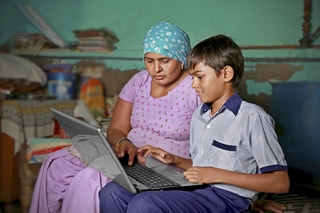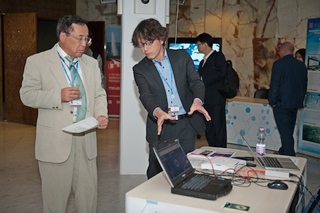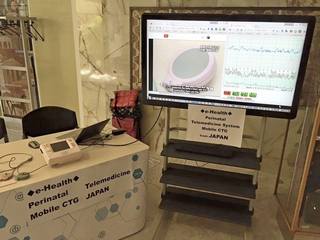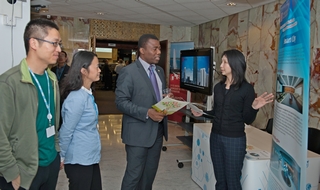During the ITU-D Study Group 2 and 1 meetings held in Geneva from 7-18 September 2015, a series of exhibitions took place to showcase innovative ICT technologies and applications which are being used to improve people's lives in different parts of the world.
The exhibits, from t he ITU Membership and invited experts, were directly linked to the various Study Group Questions under study. They featured technological developments in the fields of emergency telecommunications, ICTs for the smart society and smart city, applications for e-health, e-learning and accessibility for persons living with disability.
he ITU Membership and invited experts, were directly linked to the various Study Group Questions under study. They featured technological developments in the fields of emergency telecommunications, ICTs for the smart society and smart city, applications for e-health, e-learning and accessibility for persons living with disability.
Mr Brahima Sanou, Director of the ITU's Telecommunication Development Bureau said the exhibitions "were a great opportunity to showcase the practicality of the studies conducted by the Study Groups. The displays show the impact of our work in people's daily lives and how theory is being transformed into practice."
ITU-D Study Groups provide an opportunity for all Member States and Sector Members, Associates and Academia, to share experiences, present ideas, exchange views, and achieve consensus on appropriate strategies to address ICT priorities. They are responsible for developing Reports, Guidelines, and Recommendations based on input received from the membership. Information is gathered through surveys, contributions and case studies.
Emergency Telecommunications
Panasonic Corporation of Japan exhibited a cellular-based disaster recovery mobile network system which can be deployed rapidly when a disaster strikes. The system is capable of restoring mobile  communication and internet services for emergency responders and the public in the event of a disaster.
communication and internet services for emergency responders and the public in the event of a disaster.
The mobile cellular network system can be deployed within one hour upon arrival at a disaster zone and contains a unit with self-generated power, satellite and long range wireless communication capabilities. It is also equipped with FM radio transmitters through which authorities can send public disaster emergency broadcasting messages on relief operations.
"For over 40 years, Panasonic has been providing emergency telecommunication solutions to Japanese local governments in the event of natural disasters", said Mr Hiyoyuki Yamanaka, Senior Coordinator, Global Marketing Department at Panasonic Corporation. "Our goal is to offer first responders and humanitarian organizations quick and efficient access to voice and data connectivity in order to ensure rapid lifesaving and recovery work and at the same time allow the affected population to communicate with their loved ones in order to ease anxiety," he added.
e-Health
Melody International, a medical and healthcare service provider from Japan showcased the introduction of telemedicine in Lao People's Democratic Republic.
 The Perinatal Telemedicine System is ICT based and is being deployed in health care facilities in rural and remote areas of Lao PDR to help reduce the country's maternal and infant mortality rate.
The Perinatal Telemedicine System is ICT based and is being deployed in health care facilities in rural and remote areas of Lao PDR to help reduce the country's maternal and infant mortality rate.
The system consists of two main components: a medical information system which enables doctors and health workers in remote or rural areas to share information on expectant mothers and infants with doctors based in regional and national hospitals; and a mobile fetal heart rate monitor.
Through data shared in the telemedicine system, doctors can diagnose the level of health risk a mother and her unborn baby face during pregnancy or delivery and provide immediate and appropriate medical advice.
The system is also envisaged to improve the country's medical records storage system and provide an e-learning platform for medical professionals.
"Access to information communication technologies is crucial to expand the reach of healthcare services and health information to remote and rural areas," says Ms Yhuko Ogata, Chief Executive Officer of Melody International. "The telemedicine has been successfully deployed in several health care facilities in rural Japan and we believe that transferring this benefit to a developing country like in Lao PDR will bring significant benefits to improving maternal and child health care," adds Ms Ogata.
ICTs for the Smart City
China Communication Services, a telecommunications infrastructure service group, was at hand to showcase how ICT technologies help improve the management of big cities such as Shanghai and Nanjing.
 Government services, transport and traffic management, energy, health care, water and waste are some of the areas in which ICT technologies are being used to enhance quality and performance of services.
Government services, transport and traffic management, energy, health care, water and waste are some of the areas in which ICT technologies are being used to enhance quality and performance of services.
"Smart City is an innovative way to integrate ICTs in the daily management of urban cities and address challenges brought about by industrialization and urbanization such as public safety, environmental health, traffic congestion and waste management,"says Ms Denise Ho, Head of Research and Planning at China Communication Services.
She adds, "with the smart city concept we are in a position to provide information based on big data analysis to the public by means of web pages and mobile phone apps thereby contributing to the enhancement of the quality of life and social services."
ICT Accessibility
Four exhibitions focused on access to telecommunications/ICT services by persons with disabilities.
Among the exhibitors was VTCSecure from the United States of America which is leveraging various technologies to develop communication solutions for individuals with visual or hearing impairment.
The company showcased its technology based voice, video and text communication mediums developed for people with disabilities. By using open source technology the company is enabling people with disability not only to access assistive technologies for free, but the users can also modify them to suit their own special needs.
VTCSecure displayed the Video Remote Assistance (VRA) which is a mobile phone application designed for people with visual impairment. The application sends real-time video or pictures to a visual interpreter in a call center who describes back to the sender what the phone's camera is seeing. The company says the technology will enable a visually impaired user to get help in reading documents or navigating inside a new building.
"We believe that offering free, open source assistive technologies and applications will allow governments or any organization to easily and affordably implement communication platforms that meet the particular needs of their disabled communities, " says Mr Peter Hayes, VTCSecure Chief Executive. "Ultimately, we want to work with the ITU to create global standards and best practices, so that current ICT accessibility challenges can be addressed and solutions can become a reality", he adds.
VerbaVoice from Germany, a technology solutions company demonstrated its development of a communication support system which transfers voice into live text and sign language video for the hearing impaired. VerbaVoice's technology is also designed to transmit original audio, caption text and sign language streams simultaneously allowing users to select individual settings.
"We are investing in innovative and cost effective technology solutions in order to remove barriers to spoken communication in everyday life for hearing impaired people", says Robin Ribback, VerbaVoice Co-Founder and Chief Information Officer. "Through accessible ICTs hearing impaired people can lead an independent and self-determined life. Our highest priority is to find the perfect solution for everyone individually."
AT&T Inc. from the United States of America highlighted the development of Real-Time Text (RTT), an Internet Protocol (IP) based system that makes telephone service accessible to individuals with hearing or speech impairment.
RTT is a text based mode of communication where text is transmitted instantly while it is being typed. The recipient can immediately read the sender's text as it is written, without waiting, thus allowing for a conversational flow of communication, simultaneously with voice.
AT&T hopes that the Real-Time Text system will be an alternative to the teletypewriter (TTY) which is a special device that lets people with hearing or speech impairment use the telephone to communicate, by allowing them to type messages back and forth to one another instead of talking and listening. A TTY is required at both ends of the conversation in order to communicate.
"Real-Time Text is a more user-friendly technology that takes advantage of innovative network technologies to foster the digital inclusion of people living with disability," observed Ms Amy Alvarez, Executive Director of AT&T International External Affairs. "The TTY technology is outdated and does not work well with increasingly prevalent Voice over Internet Protocol (VoIP). It is vital that assistive communication technologies keep pace with the global technological revolution."
AT&T hopes that the Real-Time Text system will be an alternative to the teletypewriter (TTY) which is a special device that lets people with hearing or speech impairment use the telephone to communicate, by allowing them to type messages back and forth to one another instead of talking and listening. A TTY is required at both ends of the conversation in order to communicate.
"Real-Time Text is a more user-friendly technology that takes advantage of innovative network technologies to foster the digital inclusion of people living with disability," observed Ms Amy Alvarez, Executive Director of AT&T International External Affairs. "The TTY technology is outdated and does not work well with increasingly prevalent Voice over Internet Protocol (VoIP). It is vital that assistive communication technologies keep pace with the global technological revolution."
FRED (Film Radio Entertainment & Dialogue) from the United Kingdom exhibited the FRED At School project, an educational project whose primary goal is to enhance film literacy among young audiences in Europe and especially secondary school students, including the students with disabilities. The project is multilingual and multicultural and incorporates the use of radio as a creative tool for students.
All films within the project are also made accessible to students with sight or hearing impairment. Subtitles (captions) for the hearing impaired and audio description for the visually impaired are available through a specially developed smartphone application.
"Incorporating film and radio as learning tools in schools can be an innovative way to teach as well as distribute education materials widely," says Mr Federico Spoletti, FRED Managing Director. "I have been involved in promoting accessibility in the film industry for more than 5 years and I believe that promoting inclusion and accessibility among secondary school students and teachers is a very effective way to raise awareness on the issue."
N/B: Panasonic Corporation and AT&T Inc. are ITU-D Sector Members. Melody International, Japan; China Communications Services, China; VTCSecure, United States of America; VerbaVoice, Germany; FRED, United Kingdom, took part in the exhibition as experts in their respective ICT fields.
